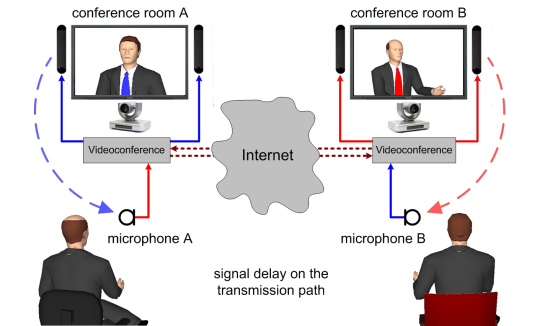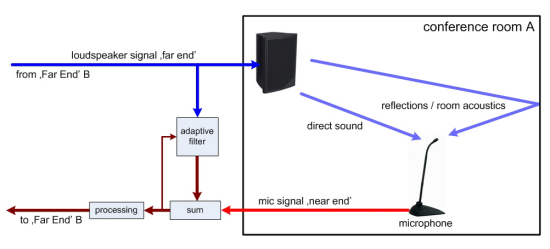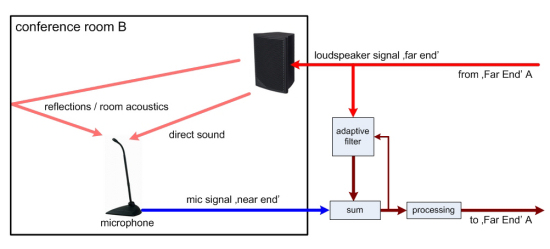


In any installation with full duplex conversation (videoconference, telephone conference) the following phenomenon will be present: The far end sound signal, reinforced with a speaker system in the room, will be captured my the room microphone(s) and will be transmitted back to the far end mixed to the original microphone signal.
To get a clean conversation this additional signals should be eliminated. The plain abstract solution is to cancel the incoming sound signal (from the far end) out of the outgoing microphone signal. This can be done with an adaptive filter. The incoming signal is inverted and added to the outgoing signal to compensate it. But because the conversation is located in a room, the room acoustic will also add additional noise (reverberant signal generated from the speaker signal). Also varying delay times of the far end signal (sound travelling from the speaker to the microphone, microphone position, several microphones) must be considered.
Any echo cancelling done in one location (the near end) is serving the other location (the far end). In case the echo situation doesn't change with the best equipment - keep in mind that the problem is on the other side ! :-)
 |
| typical videoconference - connection between two systems |
 |
| echo cancelling on site A (for site B) |
 |
| echo cancelling on site B (for site A) |
To eliminate all emerging echoes and room acoustic artifacts correctly, each microphone needs an individual echo canceller that is set up exactly for the microphone position and room characteristics. Intensive signal processing and sophisticated algorithms are necessary for good results.
Near-Side: local side of a conference call with loudspeakers and microphones, where the AEC device is installed
Far-Side: remote side of a conference call with the remote talker that will be heard through the near-side speakers
Convergence Rate: measure of how fast the AEC algorithm can identify and remove echo from the incoming signal
AEC Reference: determines which signals should be removed from the near-side microphone to prevent echos at the far-side
Echo Return Loss (ERL): measure of the room's natural attenuation of the far side signal as it leaves the near-side speaker and enters the microphone
Echo Return Loss Enhancement (ERLE): measure of how much echo is being removed from the signal as a result of the linear AEC Algorithm
Tail Time: The longest echo that can be removed by the AEC algorithm